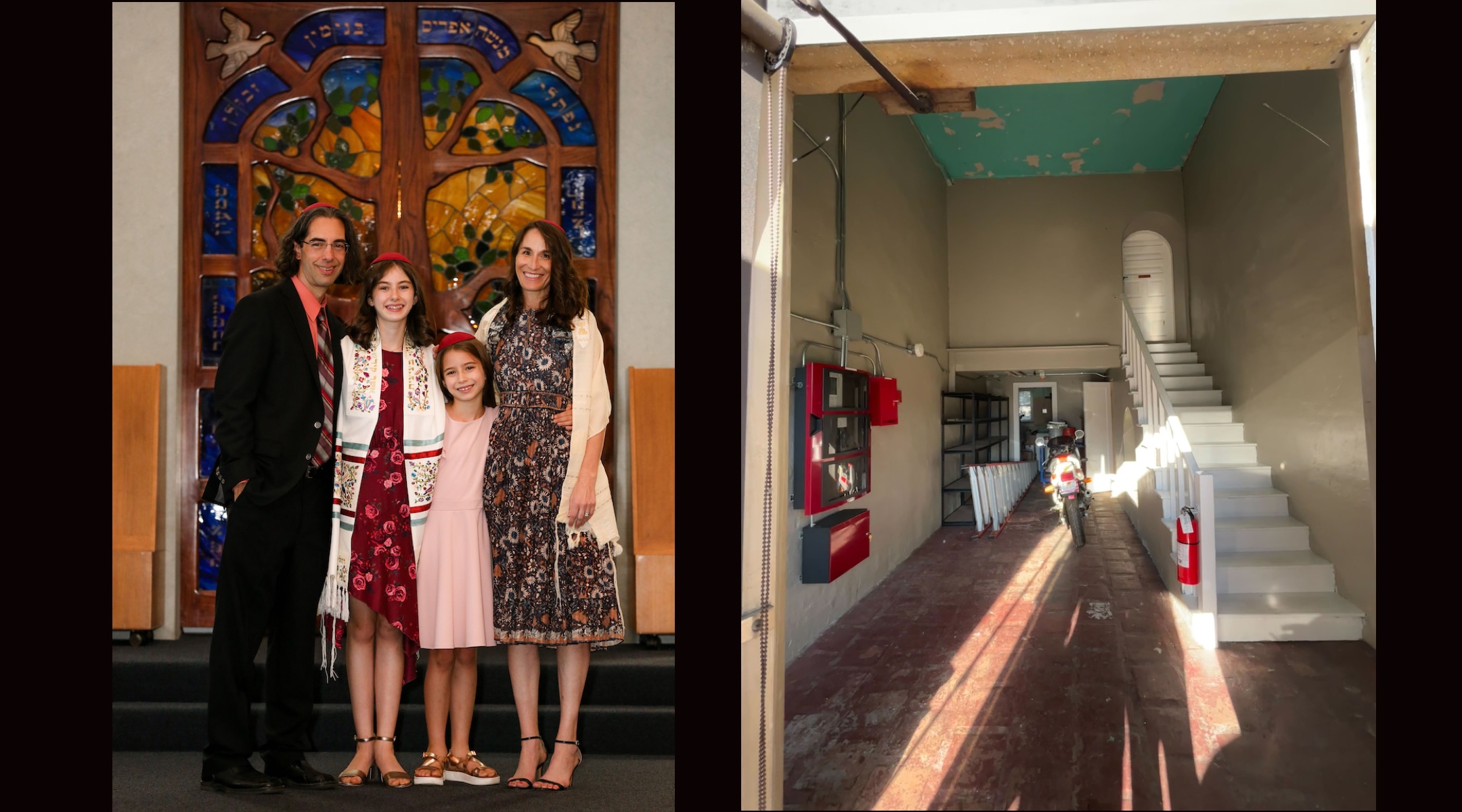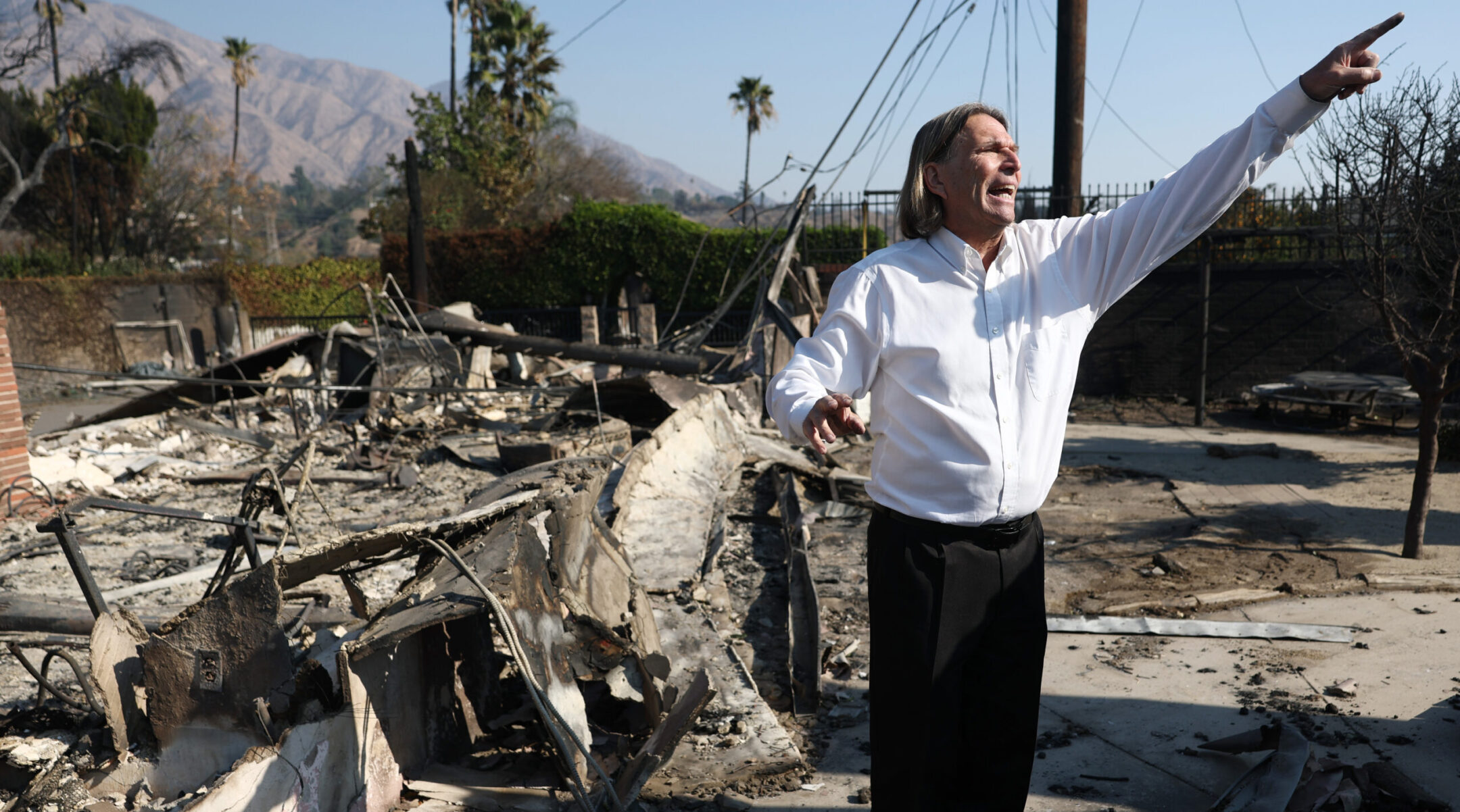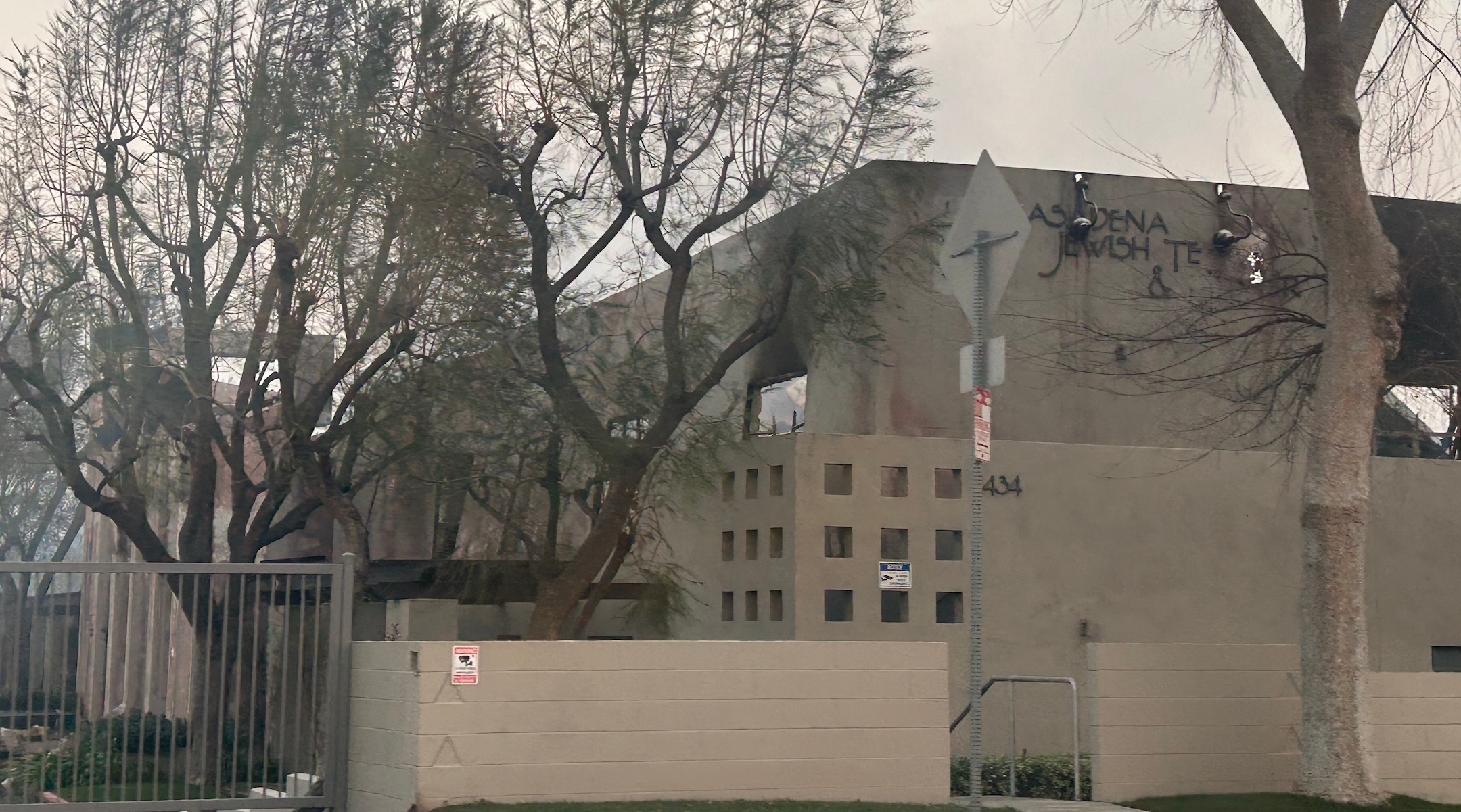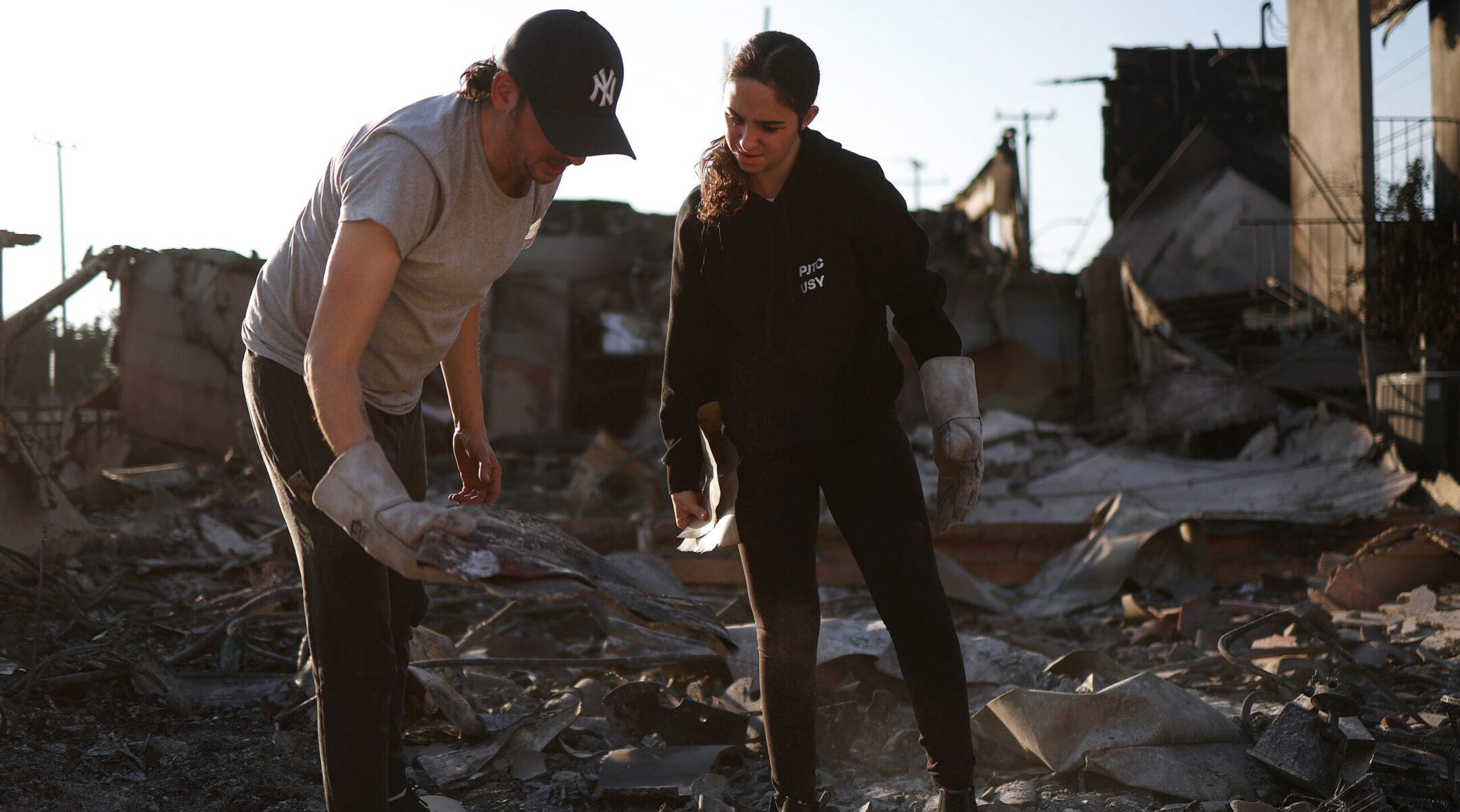LOS ANGELES — The Shabbat service was in many ways standard fare: Hundreds of Jews gathered to light candles, sing prayers, rise for reflection and eat challah, together.
But there was a big, and unexpected, difference this week for members of the Pasadena Jewish Temple and Center: Instead of convening in their synagogue’s 80-year-old building, they were in the theater of a Catholic high school six miles away.
That’s because the Pasadena Jewish Temple and Center was one of thousands of structures to burn in this week’s fires across the Los Angeles area. At least a dozen families lost their homes, too. Its Torahs safe after a harried evacuation but everything else in ashes, the synagogue has become something of a symbol of the devastation still being wrought.
Much is uncertain about how the synagogue will rebuild and operate going forward. But the Friday night service represented an early effort to demonstrate resilience, and take halting steps into an uncertain future.
A rescued Torah sat at the center of the space. Ritual items that could not be saved — tallit, kippot, and prayer books — had been donated by Chabad of Pasadena and San Diego’s Tifereth Israel Synagogue. And Rabbi Jill Wright and Cantor Ruth Berman Harris were leading the service, as they always do on Friday nights.
For attendee Sadie Zierler, 14, the takeaway was clear: “There’s no more PJTC building, but we still have PJTC because it’s in our soul,” she said, adding, “It’s so heartwarming they organized this so quickly.”
Zierler is one of dozens of teens for whom Pasadena Jewish Temple and Center, a Conservative synagogue in Pasadena, has been a heart of Jewish life. The 434-family congregation has a biweekly religious school for students up to eighth grade and both an active youth group and an assistant teacher program for teens. (The teen journalism fellow who reported this story is a congregant and youth group leader at the synagogue.)
“When we left, I did not realize I would be saying goodbye to that special place that I was literally just at last Sunday,” said Leah Bacigalupi, 17, a teacher’s assistant at the religious school.
She and her sister found out that PJTC had been destroyed via text messages in group chats. “We just broke down in tears and were just in shock,” said Leah. Members of the synagogue since Leah, now a high school senior, was in third grade, she and her 13-year-old sister said they could not imagine their life without visiting the walking-distance center weekly.
The Pasadena Jewish Temple & Center burns during the Eaton fire in Pasadena, California, on Jan. 7, 2025. (Josh Edelson/AFP via Getty Images)
“Just the fact that it’s gone, I can’t really grasp that, because it’s become such a big part of my life,” said Giana, who celebrated her bat mitzvah two months ago. Practicing at the synagogue four times per week, she “became super connected to it.”
Sofia Manacker, 16, attended PJTC weekly, serving as the programming vice president of her youth group and working as a religious school teacher’s assistant. When she first heard the news that the synagogue was burning on Tuesday morning, she was in shock — she had planned to attend a program for teens that night.
“I was in disbelief. I was in denial, hoping I was going to wake up from a nightmare and that this is all fake,” she said.
Manacker and her family live around three miles south of the synagogue and were not included in evacuation zones. Since Tuesday, the night the fire started, they have been hosting an evacuated family of five that they grew close to through PJTC programs. “They are not only a part of my community, but a part of the village that helped raise me and I would do anything to help them,” she said.

Leah Bacigalupi and her family pose in front of the ark at the Pasadena Jewish Center & Temple to mark her bat mitzvah in 2020; the storage room at the synagogue that Sophia Culver overhauled as a service project. (Courtesy)
Another teaching assistant, Emett Mendel, said the news felt “kind of a little bit dream-like. Just felt so random, out of the blue.” Mendel, 17, is also a board member of the youth group and did not have to evacuate his home.
Mendel’s connection to the synagogue runs deep. He attended its now-closed day school for a year and its religious school up until his bar mitzvah in 2020. He has continued to stay involved in high school, volunteering for the youth group’s catering team and designing “Tikkun Tech,” a program that connects tech-savvy teenagers with congregants needing technology assistance. He estimates spending five hours a week at a synagogue.
“That’s where I’ve been for the past 12 years, and that’s where my community really has been,” Mendel said.
Sophia Culver, 17, dedicated her 80-hour Girl Scout Gold Award project to revamping a storage room in the spring and summer of 2024. Cleaning the space, painting the walls, and adding shelves, she transformed a room that is now gone.
As a lifetime member of the synagogue, Culver said she was “heartbroken” after driving by the smoldering remains. “It’s so terrible to look at,” she said. “It’s devastating.”
Emily Catalano, the synagogue’s assistant director of youth engagement and education, said she has individually been checking in with families and anticipates youth group programming will not resume until next month.
“Like our teens, I’m absolutely devastated by the loss of our building,” she said. She added, “We absolutely will continue to serve our youth, though we’re not sure exactly what this looks like yet.”

Laurence Harris calls out to other congregants while walking through the remains of the Pasadena Jewish Temple & Center, which was destroyed in the Eaton Fire, Jan. 11, 2025, in Pasadena, California. (Mario Tama/Getty Images)
As emotions continue to run high for many of the synagogue’s teen members and they step back into communities with lives and spaces upended by fire, envisioning the future of Jewish life in Pasadena is difficult for them.
“I just have no clue what’s going to happen or what everyone’s going to do,” said Manacker. “ I know we are a very strong community and we’re all going to help each other, but it’s hard to picture what comes next.”
For many in the community, services on Shabbat offered the first hints of a vision.
“Our community is shattered physically and spiritually. It is OK not to be OK,” Rabbi Joshua Levine Grater, the former senior rabbi of the synagogue who left the role in 2015 to lead a local anti-poverty nonprofit, said in a sermon. (He’d been invited by Wright, a longtime congregant who recently assumed leadership after being ordained, to participate. The synagogue is in the process of hiring a permanent rabbi.)
Grater’s own home had burned, too. Little remained of his possessions, but he brought one book that survived untouched: “Sacred Fire: Torah from the Years of Fury 1939-1942,” a title that sparked laughter because of its irony.

Pasadena Jewish Center and Temple burned in the Eaton Fire in Los Angeles, Jan. 10, 2025. (Ella Bilu)
Grater sounded a note that would be repeated over and over: “Our people know what it means to be transient, without a temple, literally. Whether we are in an auditorium, church, park or wherever, as long as we are together, we have a temple. We are the temple.”
Wright announced that the Catholic school, Mayfield Senior School, had invited the synagogue to use its space not only for Friday night and Saturday morning Shabbat services, but also for a Sunday prayer service and religious school. Overtaken with gratitude, congregants began clapping — a gesture not typical during Jewish worship.
The experience left many, including the teens in attendance, feeling more optimistic than they had all week.
“I felt really bummed before today, but after the service tonight I feel a lot better about the situation,” said Noah Mukherjee, 17, after the service. “We still have a temple. It’s just in a different place.”




